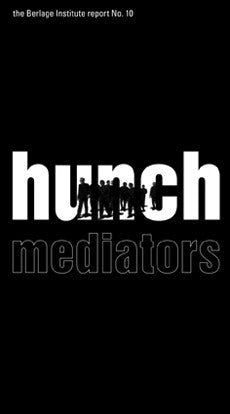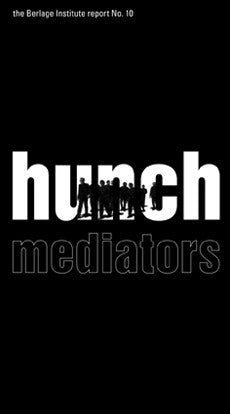Your cart is currently empty!
Urbanism
HUNCH 10
+++Mediators+++
+++Penelope Dean [ed.]+++
978-90-78525-01-1
NL Ontwerp [Nandan Lemmers]
156
30 x 16.5
Paperback
English
HUNCH 10 presents Mediators, an edition that addresses the workings of “mediation” on and through the disciplines of architecture and urbanism. Bringing together significant figures - directors, advisors, critics, curators, decision-makers, editors, and academics - operating between the various realms of public, architecture, urbanism, culture and business through influence and facilitation, HUNCH 10 exposes mediation by way of authorship, historiography, anecdotes, statistics, profiles, and photography. The material in this issue consists largely of lecture transcriptions and interviews accumulated during Spring 2004/2005 at The Berlage Institute, along with some newly commissioned material.
The format of the issue is a cast. Rather than streamlining arguments (hunch 9), or identifying emergent themes (hunch 8), hunch 10 compiles a troupe of figures that maintains a professional/ academic role in public life. It recognizes these characters as a group and provides the opportunity to describe what they do and how they do it without ideological interference. The issue does not enforce a particular editorial point of view, but rather assumes the genre of anthology: it offers a collection of personalized accounts or a series of windows - inside stories - into professional/academic worlds. The issue stands as a record of achievements and a mode of exposure. Its resultant content is not about architecture and urbanism per se, but rather the ways in which the disciplines are understood, managed, bargained and sold through third parties and points of view. In so doing, hunch 10 recasts architecture and urbanism as a content to be exposed, exhibited, tended to, and talked about.
In preview Roemer van Toorn stakes out the profiles of seven types of critics existing in The Netherlands and calls for critique to go beyond analysis and data gathering. In storyline Luis Fernández-Galiano dissects the information flow through multiple media (from books, magazines, newspapers, radio/TV, lectures, exhibitions, prizes to competitions) and suggests that publishing and teaching is the best mix for architectural mediation. Vittorio Magnago Lampugnani calls for a clear point of view within the magazine medium. In location Ricky Burdett sets out the terms and conditions of mediation in the city of London and Hans Stimmann reports on both architecture and the public in the city of Berlin. In talent Karen Stein offers her take on architectural reportage and the Pritzker Prize while Aaron Betsky gives lessons and tips for “selling architecture.” In management Phyllis Lambert argues the need for stewardship (as an act of managing) and for a renewed love of architecture. In effects Terence Riley discusses his experiences in curatorial practice and with museum audiences. Finally, Jean-Louis Cohen concludes the series with a review of the episodes that have shaped architectural exhibitions and museums from the 17th century to the present.
The opinions, lessons, viewpoints, profiles and attitudes collected here emerge as a virtual press conference through implicit conversations, inadvertent cross-references and latent hyperlinks.
Mediators
€15.00
HUNCH 10
Mediators
€15.00
Architecture / Bookazines / Series / Theory / Urbanism
978-90-78525-01-1
NL Ontwerp [Nandan Lemmers]
156
30 x 16.5
Paperback
English
HUNCH 10 presents Mediators, an edition that addresses the workings of “mediation” on and through the disciplines of architecture and urbanism. Bringing together significant figures - directors, advisors, critics, curators, decision-makers, editors, and academics - operating between the various realms of public, architecture, urbanism, culture and business through influence and facilitation, HUNCH 10 exposes mediation by way of authorship, historiography, anecdotes, statistics, profiles, and photography. The material in this issue consists largely of lecture transcriptions and interviews accumulated during Spring 2004/2005 at The Berlage Institute, along with some newly commissioned material.
The format of the issue is a cast. Rather than streamlining arguments (hunch 9), or identifying emergent themes (hunch 8), hunch 10 compiles a troupe of figures that maintains a professional/ academic role in public life. It recognizes these characters as a group and provides the opportunity to describe what they do and how they do it without ideological interference. The issue does not enforce a particular editorial point of view, but rather assumes the genre of anthology: it offers a collection of personalized accounts or a series of windows - inside stories - into professional/academic worlds. The issue stands as a record of achievements and a mode of exposure. Its resultant content is not about architecture and urbanism per se, but rather the ways in which the disciplines are understood, managed, bargained and sold through third parties and points of view. In so doing, hunch 10 recasts architecture and urbanism as a content to be exposed, exhibited, tended to, and talked about.
In preview Roemer van Toorn stakes out the profiles of seven types of critics existing in The Netherlands and calls for critique to go beyond analysis and data gathering. In storyline Luis Fernández-Galiano dissects the information flow through multiple media (from books, magazines, newspapers, radio/TV, lectures, exhibitions, prizes to competitions) and suggests that publishing and teaching is the best mix for architectural mediation. Vittorio Magnago Lampugnani calls for a clear point of view within the magazine medium. In location Ricky Burdett sets out the terms and conditions of mediation in the city of London and Hans Stimmann reports on both architecture and the public in the city of Berlin. In talent Karen Stein offers her take on architectural reportage and the Pritzker Prize while Aaron Betsky gives lessons and tips for “selling architecture.” In management Phyllis Lambert argues the need for stewardship (as an act of managing) and for a renewed love of architecture. In effects Terence Riley discusses his experiences in curatorial practice and with museum audiences. Finally, Jean-Louis Cohen concludes the series with a review of the episodes that have shaped architectural exhibitions and museums from the 17th century to the present.
The opinions, lessons, viewpoints, profiles and attitudes collected here emerge as a virtual press conference through implicit conversations, inadvertent cross-references and latent hyperlinks.



